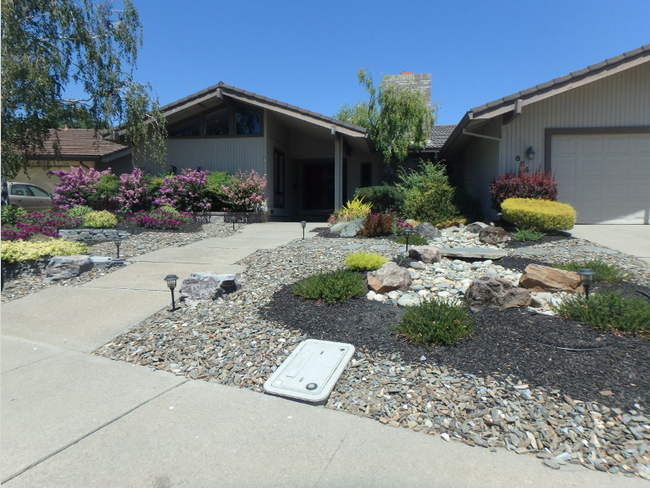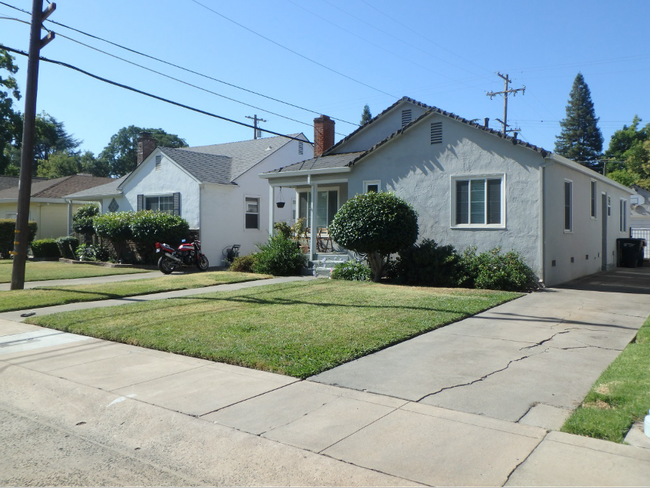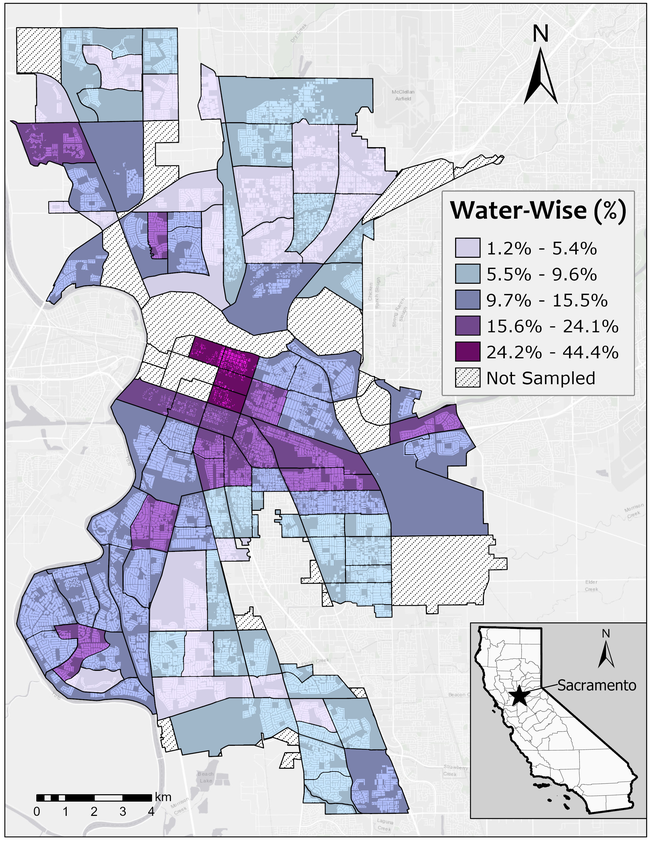Front yard with water-wise landscaping. Photo Credit: Cadenasso Lab, UC Davis
California's urban water agencies have long relied on conservation measures to promote reliability and manage costs. Since landscapes are a large portion of water demand in California cities, many water agencies encourage water conservation by incentivizing the replacement of water-intensive turf lawns with water-efficient or “water-wise” landscaping.
In California's Mediterranean climate, traditional turfgrass lawns require irrigation to maintain their appearance through the hot summer months. Inefficient, poorly managed spray irrigation systems can also result in considerable water loss from runoff and evaporation. Replacing turf and overhead sprinklers with low-water-use plants, alternative ground covers like mulch and kurapia, and more efficient drip irrigation systems can potentially save hundreds of gallons of water per square meter every year.
Although the water savings from turf replacement can be substantial, generating widespread buy-in is a challenge. Landscape renovation can be expensive and intimidating, requiring residents to learn new landscape management practices or pay for professional assistance. In addition, many people appreciate their lawns as spaces for children, pets, or entertainment. Some prefer the look of turfgrass, especially where neighborhood norms promote a unified lawn aesthetic.
To help overcome cost barriers and encourage water-wise landscaping, government agencies and water suppliers commonly offer “cash for grass” programs, in which residents are offered a rebate for landscaping expenses based on the amount of turf they replace. These programs also aim to promote neighborhood adoption of water-wise landscaping by providing attractive examples. Turf replacement incentive programs are likely to expand under proposed new water use efficiency regulations, Making Conservation a California Way of Life (AB1668 - SB606).
While large-scale, regional turf replacement programs in Southern California have been evaluated in peer-reviewed studies, questions remain about the extent and impact of these programs in other parts of the state. How widely are turf replacement programs utilized, and by whom? Are these programs responsible for a substantial amount of water-wise landscaping?
Water-wise landscaping in Sacramento
With these questions in mind, we wanted to understand how both rebate recipients and houses with independently installed water-wise landscaping were distributed across an entire city in inland Northern California. The study was recently published in the Journal of Urban Ecology.
We visually surveyed the front yards of all single-family homes in 100 census tracts across the city of Sacramento—109,062 homes in total—and compared the prevalence of water-wise landscaping with the city's turf replacement rebate data. We especially wanted to understand how this landscape water conservation measure was being adopted by communities of varying socioeconomic and demographic characteristics, and which communities were benefitting from the rebate program.
Front yard with traditional turf. Photo Credit: Cadenasso Lab, UC Davis
In Sacramento, the City's Department of Utilities has offered a rebate of (typically) $1.50 per square foot of turf removed since the summer of 2014. To qualify for the rebate, replacement landscapes must meet several criteria, including efficient irrigation systems and approved plants that cover more than half of the area at maturity. The planting requirement addresses an important concern with turf replacement—the potential for an increase in urban heat. Lawns have a cooling effect through evapotranspiration, and if they are replaced primarily with non-living groundcovers, temperatures could increase. However, such program requirements can make some residents reluctant to participate.
When we conducted our visual survey of front yards in 2018, we found that approximately 10% of Sacramento's single-family-homes had water-wise yards, while 88% had conventional lawns. Only around 3% of water-wise yards were rebate recipients, though, meaning that the vast majority—97%—of water-wise yards were landscaped independently from the city's rebate program. We also found support for neighborhood adoption effects, with clustering of water-wise yards at the city block scale.
The prevalence of independent water-wise yards should be good news for water conservation, since it would not be feasible for the city to fund many thousands of turf replacement projects. However, independent turf replacement projects don't need to comply with the city's requirements for plant coverage or irrigation system efficiency, meaning that they could be contributing to increased urban temperatures or failing to save water.
Our study also showed that water-wise landscaping was more common in census tracts with less diverse, more highly educated, and more affluent populations, as well as fewer households with children. Rebate recipients followed the same trends, suggesting that rebates weren't overcoming barriers to adoption. The uneven distribution of resources necessary for turf replacement—money, time, and information—is likely an important driver of this pattern, along with cultural or functional preferences for lawns. Lawns may play a particularly important role for families as spaces for children to play.
Photo Credit: Cadenasso Lab, UC Davis
A Tool in the Toolbox
Turf replacement is one important tool in the water conservation toolbox, and our research suggests that many residents voluntarily install water-wise landscapes even without a rebate. However, adoption is not equal across communities. The roots of this disparity likely reflect uneven distributions of resources and preferences.
With thoughtful program design and outreach, incentive programs could help overcome some of these barriers, although funding and staffing limitations in water agencies pose a challenge for implementation. For instance, carefully crafted direct installation programs could reach lower-income residents who find it difficult to pay up-front costs associated with rebates. Tailoring efforts to the needs of lower-income and marginalized communities will be important to ensure that they do not end up with unirrigated, high-heat landscapes instead of attractive, water-wise yards.
In the Sacramento region, focus groups conducted for the Regional Water Authority revealed that some residents have a very strong preference for lawns. In these cases, water suppliers may have greater impact by promoting efficient irrigation practices, turfgrass varieties that use less water, and climate-appropriate shade trees. Partial lawn conversions are also a viable water-saving strategy, and one that Sacramento's rebate program supports.
As California's cities grapple with climate change, water reliability, cost effectiveness, and meeting new water use efficiency standards, reducing high-water-use turf lawns will continue to be an important adaptation strategy. Figuring out how to support effective and equitable landscape water conservation programs must be a focus of future research and evaluation studies to promote a California where everyone benefits from climate adaptation measures.
Joanna Solins is an Environmental Horticulture Advisor with UC Cooperative Extension, serving Sacramento, Solano, and Yolo Counties, and is an Affiliate Researcher with the California Institute for Water Resources and the UC Davis Department of Plant Sciences.
Acknowledgments: Many thanks to Erik Porse, Amy Talbot, Jasmin Green, and Mary Cadenasso for their input and assistance with this post.
Additional Reading
Green, J. C., Solins, J. P., Brissette, L. E. G., Benning, T. L., Gould, K., Bell, E. M., & Cadenasso, M. L. (2024). Patterns of water-wise residential landscaping in a drought-prone city. Journal of Urban Ecology, 10(1), juae003. https://doi.org/10.1093/jue/juae003
Alliance for Water Efficiency. (2019). Landscape transformation: Assessment of water utility programs and market readiness evaluation. https://www.allianceforwaterefficiency.org/impact/our-work/landscape-transformation-assessment-water-utility-programs-and-market-readiness
Matlock, M., Whipple, R., & Shaw, R. (2019). Just for the turf of it: Turf replacement as a water conservation tool. Journal of Soil and Water Conservation, 74(5), 449–455. https://doi.org/10.2489/jswc.74.5.449
Pincetl, S., Gillespie, T. W., Pataki, D. E., Porse, E., Jia, S., Kidera, E., Nobles, N., Rodriguez, J., & Choi, D. (2019). Evaluating the effects of turf-replacement programs in Los Angeles. Landscape and Urban Planning, 185, 210–221. https://doi.org/10.1016/j.landurbplan.2019.01.011
Simpson, S.-A., Altschuld, C., Ortiz, A., & Aravena, M. (2023). Green to gold mile: An environmental justice analysis of drought and mitigation policy impacts on home landscapes in Sacramento California. Landscape and Urban Planning, 234, 104729. https://doi.org/10.1016/j.landurbplan.2023.104729


